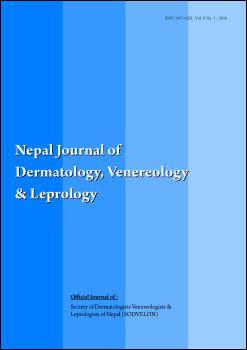Emerging trends of nosocomial Citrobacter species surgical wound infection: concern for infection control
DOI:
https://doi.org/10.3126/njdvl.v9i1.5762Keywords:
Citrobacter sp., Multi-drug resistant, surgical wound infection.Abstract
Background Surgical wound infection is a common problem among patients who undergo operation. Several factors play important role in this infection process including endemic nosocomial infection without proper infection control measures.
Objectives To study the occurrence of the pathogens in post-operative wound infections, their antibiotic resistance patterns, and comparison with published reports.
Methods Various specimens obtained from the surgical wound during a period of four months were processed for bacteriological culture in the Department of Microbiology, Kathmandu Medical College, Kathmandu. Antibiotic susceptibility test was performed by Kirby-Bauer disk diffusion test for pathogens isolated. The relevant literatures were searched and compared with the present study.
Results Among 79 culture positive cultures, Citrobacter sp. (n=23) was most frequently isolated from surgical wound infection. Twenty strains were multidrug resistant. In comparison with other studies, this study highlights the emergence multi-drug resistant Citrobacter sp. as a leading cause of surgical wound infection. E. coli, Staphylococcus aureus, Acinetobacter sp., Klebsiella pneumoniae, Pseudomonas aeruginosa, Proteus sp., and Enterobacter sp. were also isolated from 19, 13, 10, 8, 2, 2, and 2 cultures, respectively. More than 50% of these pathogens were resistant to most of the β-lactam antibiotics tested and most of them were multi-drug resistant while these pathogens showed variable level of resistance to fluroquinolones and amino glycosides.
Conclusion The frequent isolation of multi-drug resistant nosocomial strains of Citrobacter sp. in surgical wound infection is a remarkable trend. This pathogen and their resistant genes could be endemic to the institution and can cause difficult-to-treat infection if infection control committee is not revitalized and infection control strategies are not implemented.
Key words Citrobacter sp.; Multi-drug resistant; surgical wound infection.
DOI: http://dx.doi.org/10.3126/njdvl.v9i1.5762
NJDVL 2010; 9(1): 10-14
Downloads
Downloads
How to Cite
Issue
Section
License
Copyright on any research article is transferred in full to Nepal Journal of Dermatology, Venereology & Leprology upon publication. The copyright transfer includes the right to reproduce and distribute the article in any form of reproduction (printing, electronic media or any other form).




